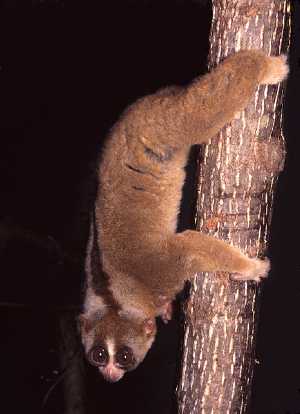 Sunda
Slow Loris Sunda
Slow LorisNycticebus
courang (aka Greater Slow Loris)
Description
The Sunda slow loris is distinguished from
other lorises by dark rings around its large
eyes, a white nose with an obvious whitish strip
that extends to the forehead, and a dark stripe
that stretches from the back of the head along
the spine. Its fur ranges from light brown to
deep reddish brown, with a lighter underside.
Length ranges from 10 to 15 inches, and weight
21-24 ounces. Male and female Sunda slow lorises
do not vary by color, size or weight.
Distribution and
Habitat
The Sunda loris is found in Indonesia,
Malaysia, the southern peninsular area of
Thailand, and throughout Singapore. Although it
prefers primary and secondary tropical lowland
forests, it is adaptable and will also live in
other types of habitat, including disturbed and
logged forests.
Reproduction
Mating can occur any time of the year.
Although males will track females in heat, all
mating is initiated by females. To initiate, the
female hangs from a branch within sight of the
male, often vocalizing to draw further attention.
The mating act itself is performed while the
couple is hanging from a branch. One offspring
(rarely twins) is born after a gestation period
of about 188 days. Only females care for their
young. Before and during weaning (which occurs at
3-6 months), females lick their young, covering
them in toxic oil, so the young may be protected
while the female leaves to forage. Females also
provide an example from which the young will
learn to move through the trees. Independence is
achieved at 16-26 months. Average lifespan in the
wild is about 20 years.
Diet
Roughly one third of the Sunda loris's diet is
saps and gums, another third consists of nectar
and nectar-producing plants, and approximately
one fourth of their diet is fruit. The remainder
of its diet consists of random items, such as
snails and eggs.
Other Habits and
Behaviors
Sunda lorises move slowly through trees on all
four limbs, typically with three limbs attached
to support at any given time.
Although they are normally solitary, Sunda
lorises do not appear to defend their home
ranges, nor do they show any hesitation in
entering another individual's home range. The
individual's range serves as a general ground for
activity, with no actual attachment to the range
except by habit.
Adults exhibit eight distinct calls of one of
two types, contact and aggressive/defensive.
Smell plays a central role in interactions, with
uses ranging from alerting others of identity, to
physical state, and even positioning of the
individual. Their elbows contain glands that
exude oils, which are licked and spread by the
individual to communicate position and status.
When locating the scent of another, the
individual will usually rub its face on the
surface where the scent was found. The oil is
poisonous, with enough power to kill an adult
human if not treated properly. If threatened,
lorises will roll into a ball, leaving nothing
but toxic fur exposed to the predator. Lorises
may also roll into a ball and drop from the trees
if the predator is arboreal.
Conservation Status
The Sunda slow loris is greatly threatened by
the pet trade and habitat encroachment, as well
as by gathering for illegal traditional medicine.
Scientific
Classification
phylum Chordata
subphylum Vertebrata
class
Mammalia
order
Primates
suborder Strepsirrhini
family Lorisidae
genus & species Nycticebus courang
Questions or comments about
this page?
|



